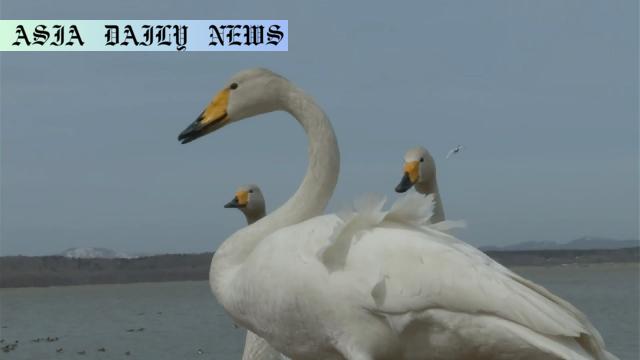Swans: Thousands of swans arrive at an internationally recognized wetland on Japan’s northern island of Hokkaido.
Swans flock to Japan’s Hokkaido wetland, designated under Ramsar Convention.
Approximately 2,000 swans enjoy their migration stop with barley feed provided by workers.
The wetland serves as a vital stopover for migratory birds before heading to Russia for breeding.
Locals and visitors are encouraged to witness the spectacle during this period.

Introduction: A Natural Spectacle in Japan
Each spring, the northern island of Hokkaido in Japan witnesses an awe-inspiring natural spectacle as thousands of migratory swans arrive at Kutcharo-ko, an internationally recognized wetland. These swans, primarily of the tundra and whooper varieties, grace the serene waters of this habitat, creating a sight that captivates both locals and tourists alike. Registered under the Ramsar Convention, Kutcharo-ko stands as a vital pit stop for these majestic birds as they journey toward their breeding grounds in Russia.
The Ramsar Convention and Its Significance
The inclusion of Kutcharo-ko under the Ramsar Convention highlights the global importance of preserving wetlands, which play a crucial role in maintaining biodiversity and supporting migratory species. This treaty, aimed at conserving wetlands worldwide, underscores the ecological value of habitats like Kutcharo-ko. For the swans, the lake offers a safe haven where they can rest, feed, and prepare for the arduous journey ahead. Additionally, the site’s recognition draws international attention, bolstering conservation efforts and fostering greater appreciation among visitors for the natural world.
A Haven for Migratory Birds
Hamatonbetsu’s Kutcharo-ko is not only a sanctuary for swans but a vital habitat for numerous waterfowl species. As the season progresses, the number of swans at the lake continues to rise, with recent counts confirming approximately 2,000 birds. This influx peaks interest among bird-watchers and nature enthusiasts, who flock to the observatory to witness the spectacle. The sight of these elegant birds feeding on barley scattered by observatory workers is a testament to the harmonious coexistence of humans and nature in preserving precious ecosystems.
A Seasonal Phenomenon with Broader Implications
The annual migration of these swans is not merely a seasonal phenomenon but a reminder of the intricate interconnectedness of global ecosystems. Their journey from Honshu to Russia reveals the challenges migratory birds face, from habitat loss to climate change, which threaten their survival. Events like the arrival of swans at Hokkaido highlight the urgent need for continued efforts in wetland conservation and wildlife preservation, ensuring these rituals of nature continue for generations to come.
Encouraging Visitor Participation
Local officials and conservation workers actively encourage visitors to experience this natural wonder. The Hamatombetsu Lake Kutcharo Waterfowl Observatory plays a pivotal role in fostering awareness and education, offering insights into swan behavior and the importance of wetland conservation. As more swans arrive in the coming weeks, the site is expected to draw larger crowds, igniting a sense of wonder and responsibility among onlookers. Observing these graceful creatures in their natural habitat fosters a deeper appreciation for the environment and the delicate balance of ecosystems.
Conclusion: Embracing Conservation and Connection
The arrival of thousands of swans at Kutcharo-ko is a powerful testament to the beauty and fragility of nature. It offers an opportunity for visitors and locals to connect with wildlife and reflect on the importance of preserving our planet’s ecosystems. As these swans prepare to embark on their journey to Russia, their presence at Hokkaido serves as both a spectacle to behold and a call to action for conservation efforts worldwide.
Commentary
Witnessing the Beauty of Swans
The migration of swans to Hokkaido’s picturesque wetland is undoubtedly one of nature’s most breathtaking sights. As visitors gather to witness the pristine beauty of these elegant creatures, they become part of a larger story—one that emphasizes the importance of connecting with and protecting our planet’s ecosystems. Watching the swans glide across Kutcharo-ko’s tranquil waters serves as a timeless reminder of nature’s ability to inspire awe.
The Role of Wetland Conservation
This annual event also highlights the critical role that wetlands like Kutcharo-ko play in supporting migratory birds and maintaining broader biodiversity. By providing a safe resting and feeding ground, these wetlands give birds the chance to recover and refuel for the next leg of their journey. The Ramsar Convention’s commitment to conserving such habitats is essential, as it ensures places like Kutcharo-ko remain sanctuaries for wildlife while fostering global awareness.
Balancing Tourism and Preservation
On the other hand, the growing interest in witnessing the swans’ migration raises questions about balancing tourism with preservation. While it’s encouraging to see people engage with nature, it’s equally vital to manage human activity responsibly to avoid disrupting the fragile ecosystems we aim to protect. Thankfully, initiatives by observatories such as the one at Hamatonbetsu aim to educate visitors on ethical practices, ensuring that the swans—and other wildlife—remain undisturbed.
A Personal Reflection
Personally, the story of these 2,000 swans fills me with admiration and hope. Their journey is a metaphor for perseverance and resilience. It also reinforces our role as stewards of the environment, reminding us that our actions, however small, can have lasting impacts. Visiting a place like Kutcharo-ko would be an incredible experience—a chance to witness not just the beauty of nature but also its interconnectedness and the importance of sustaining it.


